Growth marketing, as its name suggests, is all about taking care of all parts of the marketing funnel, which means having a well-structured solution for all steps starting from acquisition through to retention and referral.
Given that growth marketing is an ongoing journey with lots of different elements and touchpoints, we think that it’s very helpful for you to have a guide that answers any growth marketing-related questions you have.
In this guide, we’re going to discuss everything around growth marketing, including:
- What growth marketing is
- What a growth marketer is
- What some prominent growth marketing tactics to implement are
Plus, we’ll be sharing inspiring examples of some very successful growth marketing models.
Let’s get into it.
Table of Contents
6 Inspiring Examples of Growth Marketing Strategies
The 4 Most Prominent Growth Marketing Tactics to Implement
What is Growth Marketing?
Growth marketing is a type of marketing that focuses on the entire marketing funnel, in an effort to help a company acquire new customers, retain those customers, and turn them into brand advocates for the company.
As you can probably imagine, it’s a long-term, ongoing process of different marketing strategies and means trying out different channels and methodologies for acquisition, retention, and referral, depending on the stages of the company’s funnel.
Moreover, a growth marketing strategy is created around different metrics, such as customer lifetime value, customer retention rate, and conversion rates.
Overall, it’s all about monitoring the entire customer lifecycle and trying to make all the necessary improvements in order to solve pain points and give your customers a seamless experience with your brand.
Author’s Note: Sean Ellis was the one who coined the term ‘growth hacking’ and led early growth with huge businesses like Dropbox and Eventbrite.
Now, let’s try to break down the “what” behind a growth marketer.
What is a Growth Marketer?
A growth marketer, also known as a growth hacker, growth marketing manager, and even growth manager, is a professional who focuses on growing a business by taking care of the entire customer lifecycle.
They do this by creating growth opportunities not only in terms of acquiring new customers, but also in terms of retaining existing customers and developing brand advocates for the company.
Whether it’s through digital marketing, content marketing, email marketing, or any other type of marketing, a growth marketing team leads all their marketing efforts towards increased customer acquisition and satisfaction, and therefore towards customer retention and brand advocacy.
Successful growth marketers have a strong skill set that allows them to create personalized marketing campaigns and implement various experiments that allow them to develop tactics and strategies that work.
Their campaigns aim at both acquiring new customers across multiple channels, but most importantly, at maintaining the existing customer base and reducing customer churn.
Last but not least, growth marketers are different from traditional marketers mostly because they don’t focus solely on brand awareness – although that’s also part of their job – as much as they care about optimizing the entire customer journey.
If you are looking for professional help, you can find someone here: Growth Marketing Specialist Jobs.
The examples that follow come from companies that seem to be getting growth marketing right.
Let’s take a look at how they’re driving growth.
6 Inspiring Examples of Growth Marketing Strategies
As promised, in this section we’re looking at six examples of companies that get growth right.
More specifically, we’re examining the sustainable growth marketing strategies they’ve used to succeed.
Without further ado, we’re diving right into the first example we have for you.
Example #1: Glossier
The first example we want to talk about is the successful beauty brand, Glossier.
First things first, Glossier belongs to the global cosmetic products market that is expected to reach around $863 billion in 2024.
That’s quite an impressive number, isn’t it?
Even though the number above refers to the total value of the cosmetic products market, the following stat about Glossier, in particular, is also surprising.
Have a look at the following graphic:
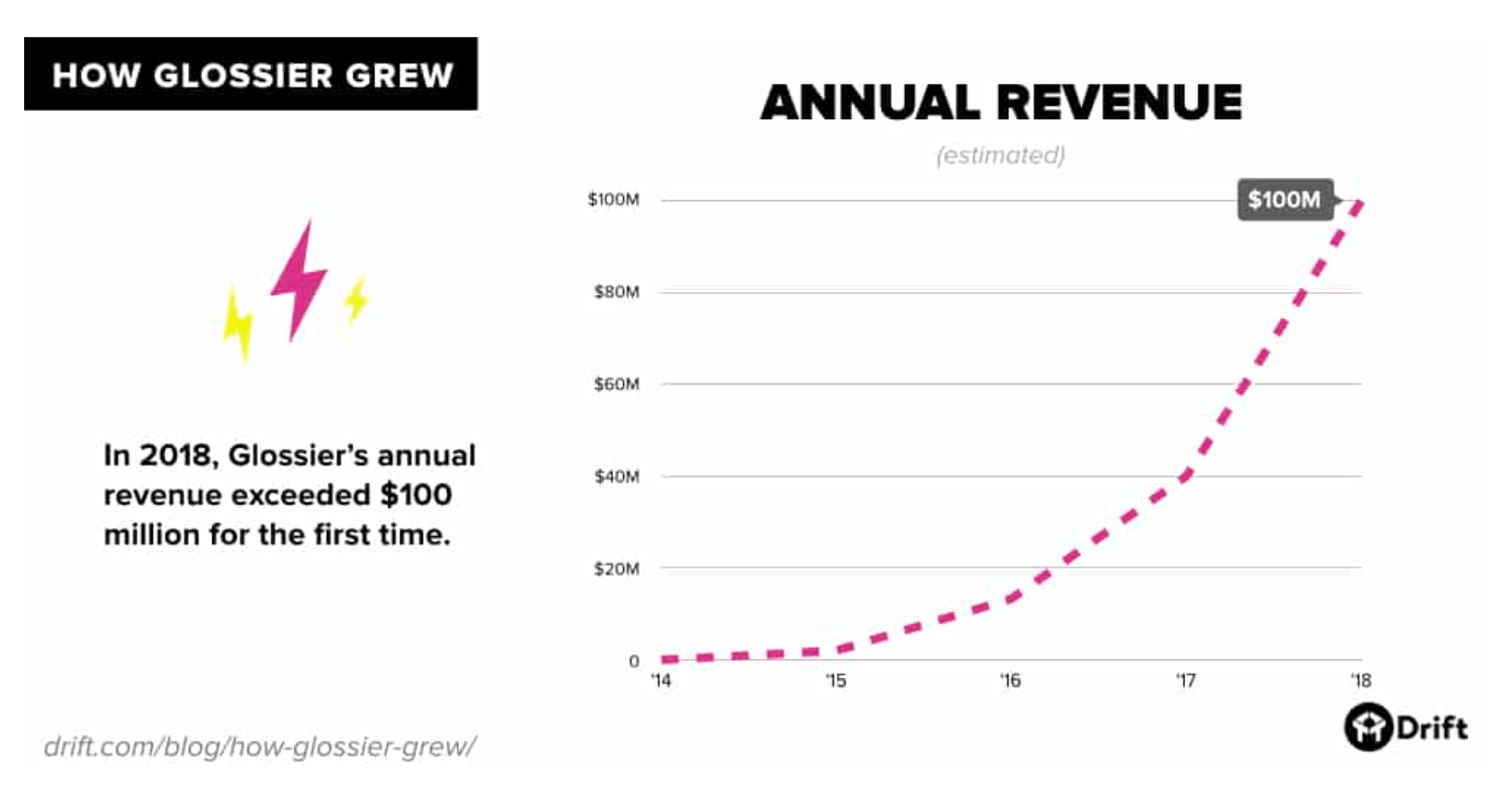
Image Source: Drift
As you can see, the company’s annual revenue hit over $100 million in 2018, only four years after its launch in 2014.
Today, Glossier is valued at $1.2 billion and has some 2.7 million followers on Instagram.
It must have a secret where all its growth came from, right?
Hmm… it’s not exactly a secret!
Glossier has been using the power of word-of-mouth marketing through its social media platforms as well as the dynamic of a strong brand community ever since it was established in 2014.
More specifically, the company’s growth marketing strategy seems to heavily rely on its customers being satisfied with the brand and feeling that they’re a part of the Glossier community.
Moreover, a quick look at Glossier’s Instagram account shows us that the company uses quite a lot of user-generated content (UGC) which enhances the creation of a community and a loyal customer base around the brand.

Image Source: Instagram
Using content created by its users, the company also achieves authenticity and adopts a more realistic social media marketing approach.
In other words, Glossier focuses on sharing brand experiences that look real instead of filtered content that looks unattainable.
Plus, it’s also established a referral program, which we’re going to have a look at a little further down in this post.
Key Glossier growth tactics:
- Build a community
- Social media marketing
- Encourage and promote UGC
- Establish a rewarding referral program
Let’s get to the next example we have for you.
Example #2: Veed.io
The second example is the video editing company Veed, which will provide us with lots of interesting findings.
First of all, Veed was established in 2019 and has, since then, experienced exponential growth which can be summarized in the following numbers:
- It went from 0 to 500K monthly visitors in a really short timeframe
- The company went from 0 to 1million ARR (annual recurring revenue) in a year
Have a look:
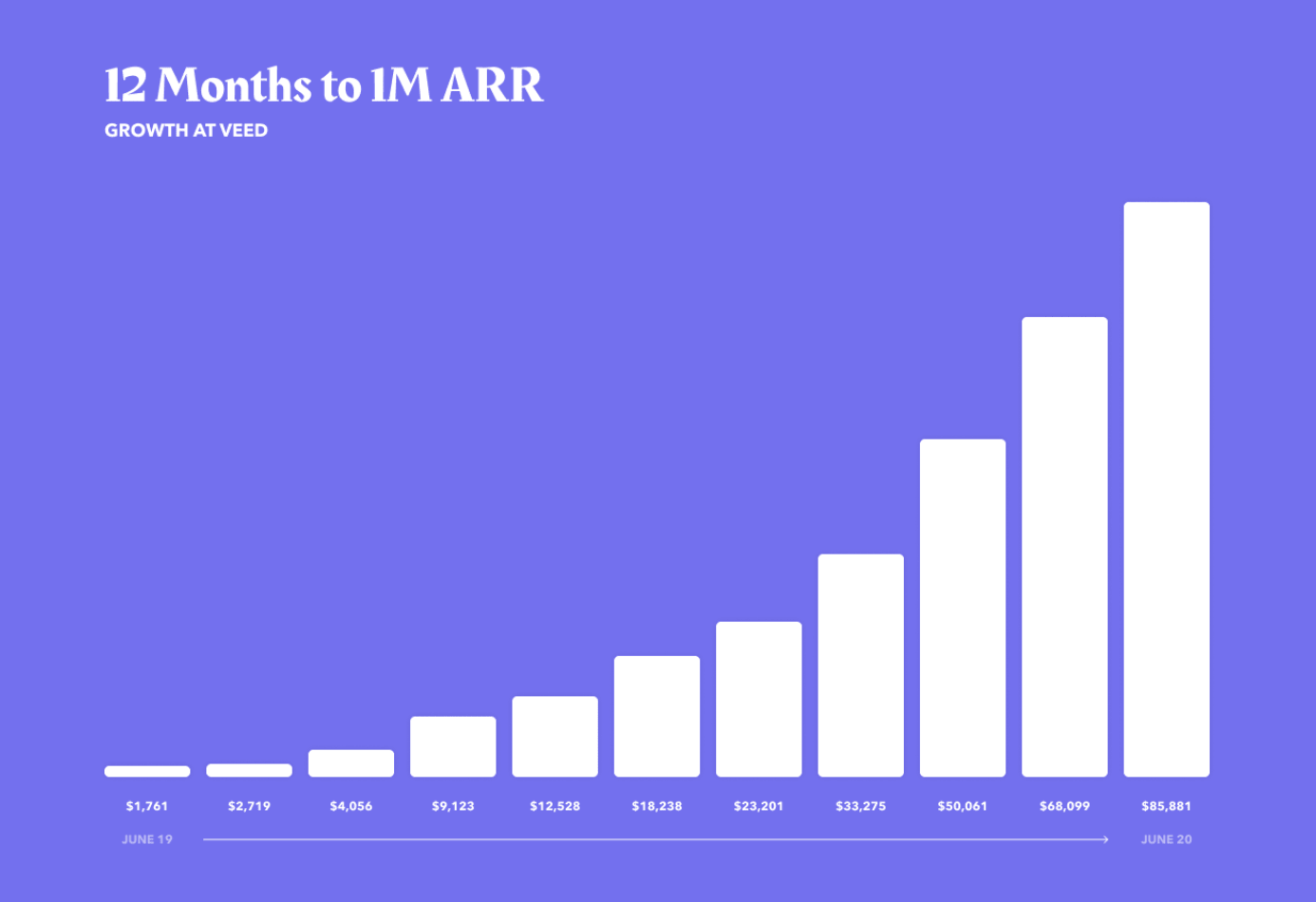
Image Source: Veed
Note: For the record, the graphic above shows the company’s growth only in its first year. The company’s revenue is even higher at the moment, reaching around $5 million ARR.
How did Veed manage to be such a successful startup growth marketing case study?
For starters, it focused its product development energy on a user-centric approach.
An example of this is that Veed offers optional onboarding calls with the co-founders – – Sabba and Tim – to new users who sign up for the product.
This might be time-consuming and even exhausting, but it can make a huge difference in terms of user experience optimization.
Apart from providing new users with valuable information and insights about the product, such a move also provides the company with insights on user feedback and helps them create a systematic product improvement approach.
For the record, Veed started as a tool with only four features:
- Trim
- Crop
- Draw
- Text
It later focused on learning from users and went on to build a product that includes all their required features which it constantly renews and optimizes.
Here are some of the tools users can take advantage of:
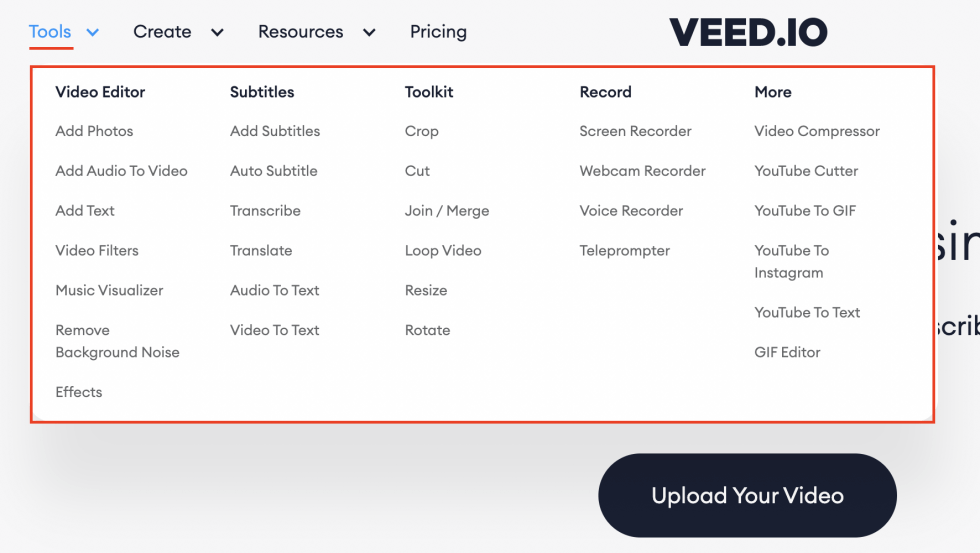
Image Source: Veed
That’s quite a big improvement if you consider it started out with those four features, right?
We could say that the main point about Veed’s growth strategy is encapsulated in the screenshot above.
As you can see, if you click on the Tools folder, you get a huge number of different tools.
If you click on any of them, you’ll get to designated landing pages.
The same applies to the Create and Resources folders.
Wanna see some numbers?
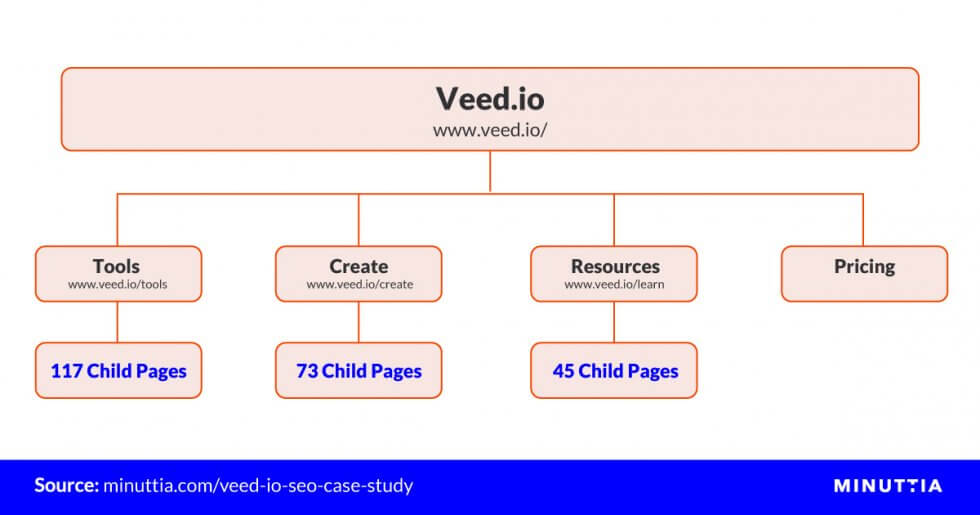
Image Source: MINUTTIA
As you can see, the Tools folder alone has some 117 child pages.
The reason why that’s so important is that a high number of landing pages brings exceptional traffic.
In other words, a great number of pages significantly contribute to the website’s organic traffic and visibility, causing impressive growth.
To put it simply, these landing pages are a vital source of traffic for Veed.
Apart from that, the company seems to pay a lot of attention to creating SEO-friendly content for its blog.
How do we know?
By doing a simple Google search for a common query about video editing, we see that Veed’s got the featured snippet which means that its content – both from its blog and YouTube channel – comes first in the SERP.
Have a look:
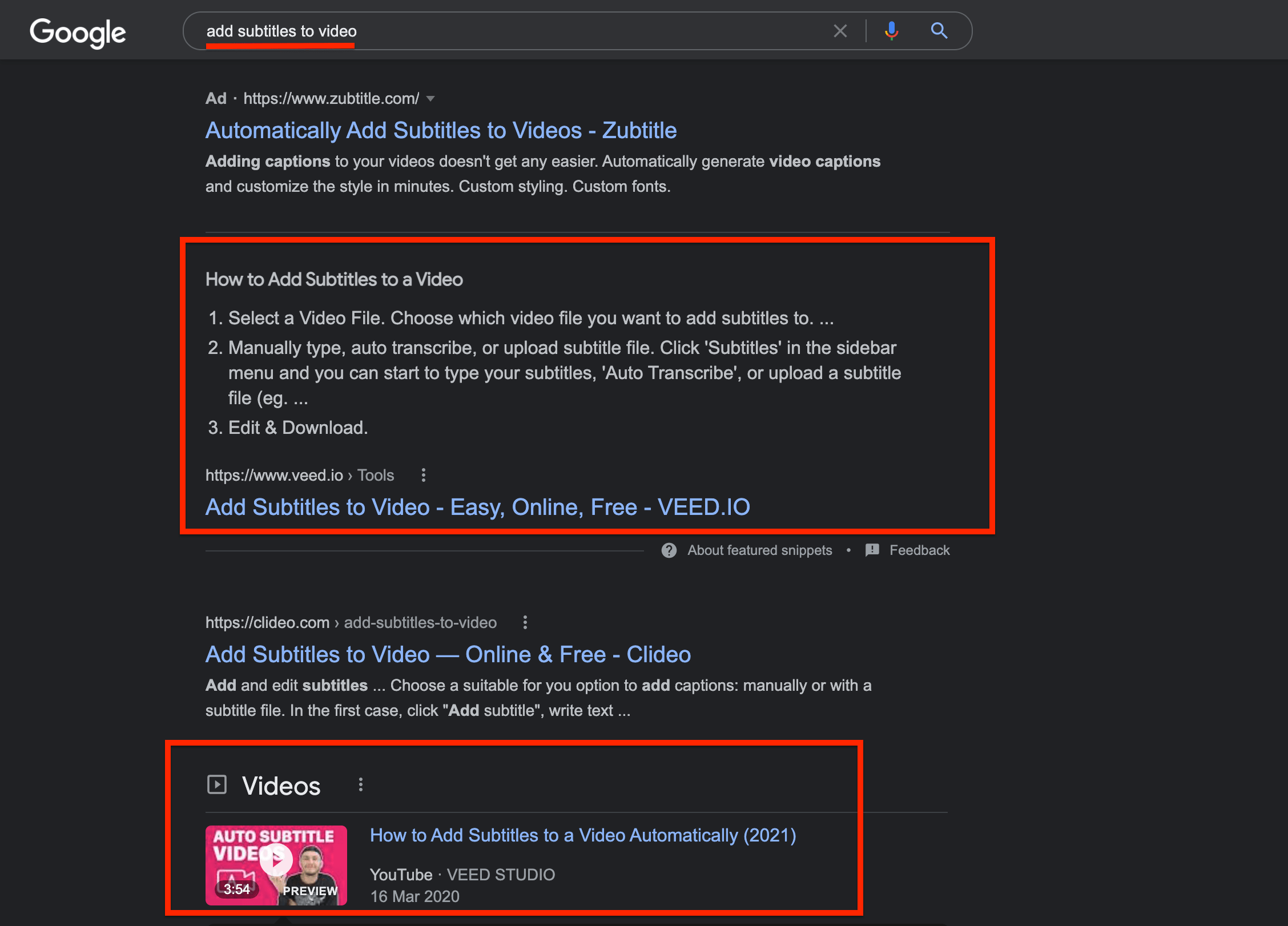
This basically means that its content is valuable and thus more likely to be found online, which leads to increased organic traffic.
Focusing on organic growth in addition to creating a community of happy users has definitely played a significant role in Veed’s remarkable growth.
Key Veed growth tactics:
- Creation of designated job-to-be-done landing pages that bring significant traffic to the website
- Focus on content marketing
- SEO optimized content
Keep reading to find our next interesting example.
Example #3: Lemlist
Lemlist, a sales automation tool, is yet another interesting example of a business going from $0 to $6 million ARR in three years.
Let’s take a moment to have a look at the graphic below and think about the rate of growth here:

Image Source: Lemlist
Taking a closer look at Lemlist’s efficient go-to-market strategy gives us a clear idea of the fact that the company has been focusing – big time! – on generating buzz and bringing awareness to the product since its launch.
To get there, the Lemlist team has also been bringing attention to building something more than a community; they’ve focused on ‘building’ a family of happy and loyal followers that happily advocate for the brand they feel so connected to.
On that note, this Email Outreach Family Facebook group has some 17K members.
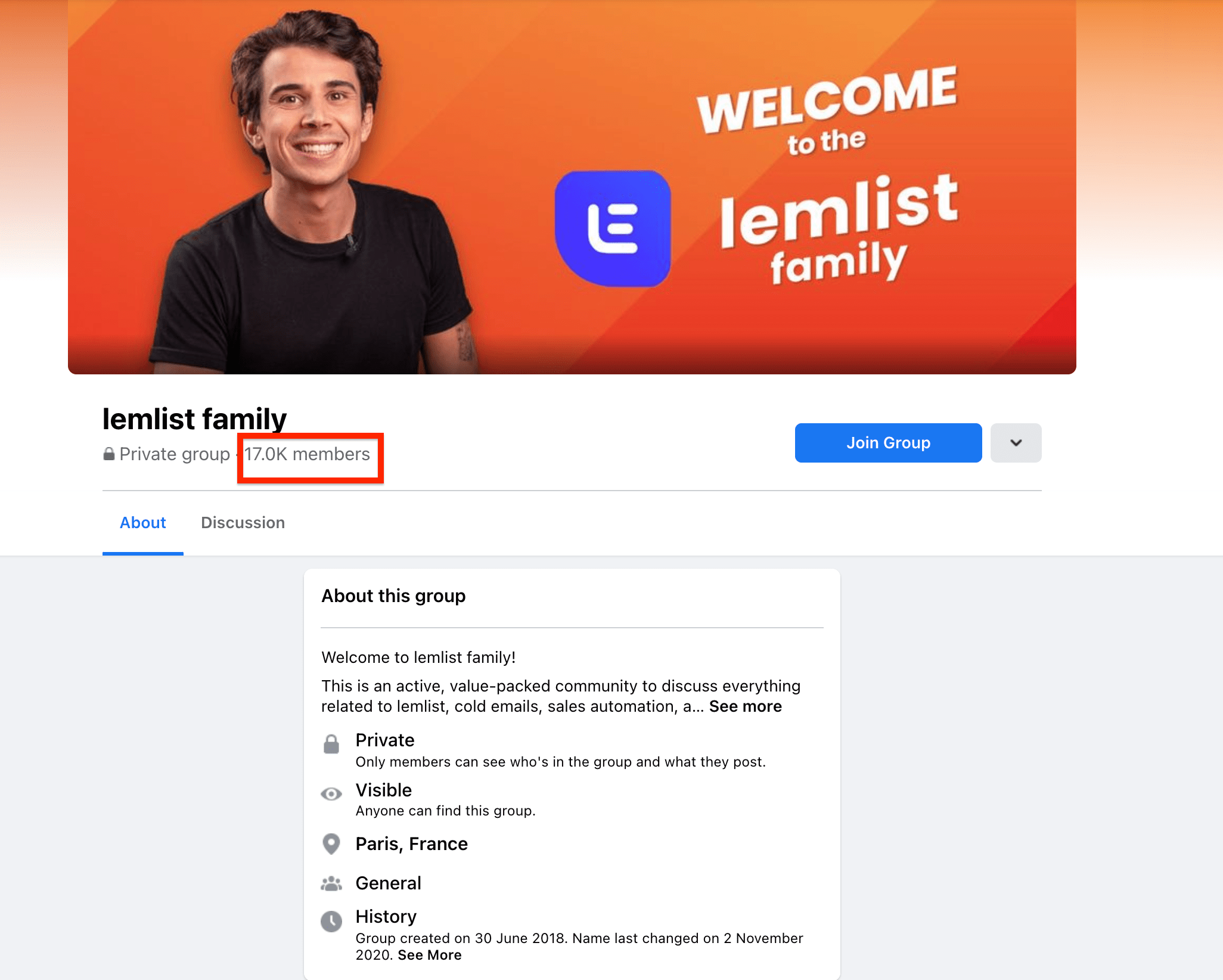 Image Source: Facebook
Image Source: Facebook
From this, we understand that the growth marketing approach of Lemlist lies in its connection with its customer base by building a community.
But it’s not just that!
Lemlist has taken storytelling to the next level.
Let’s have a look at just one out of many videos Guillaume has posted on YouTube:
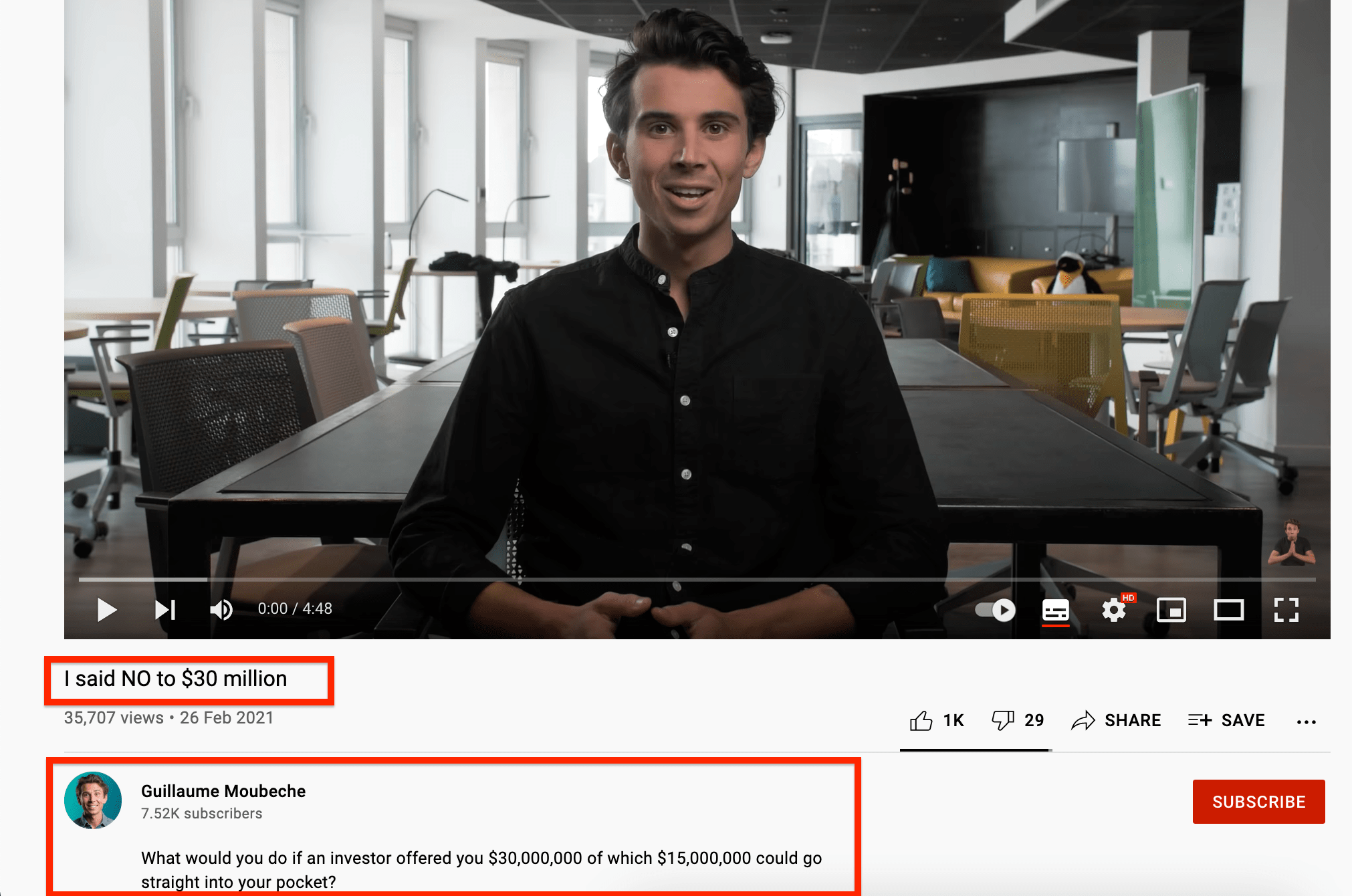
Image Source: YouTube
The title and video copy alone are eye-catching and engaging, making any viewer want to know more about it.
The same applies to a recent post that Guillaume made on his personal LinkedIn profile:
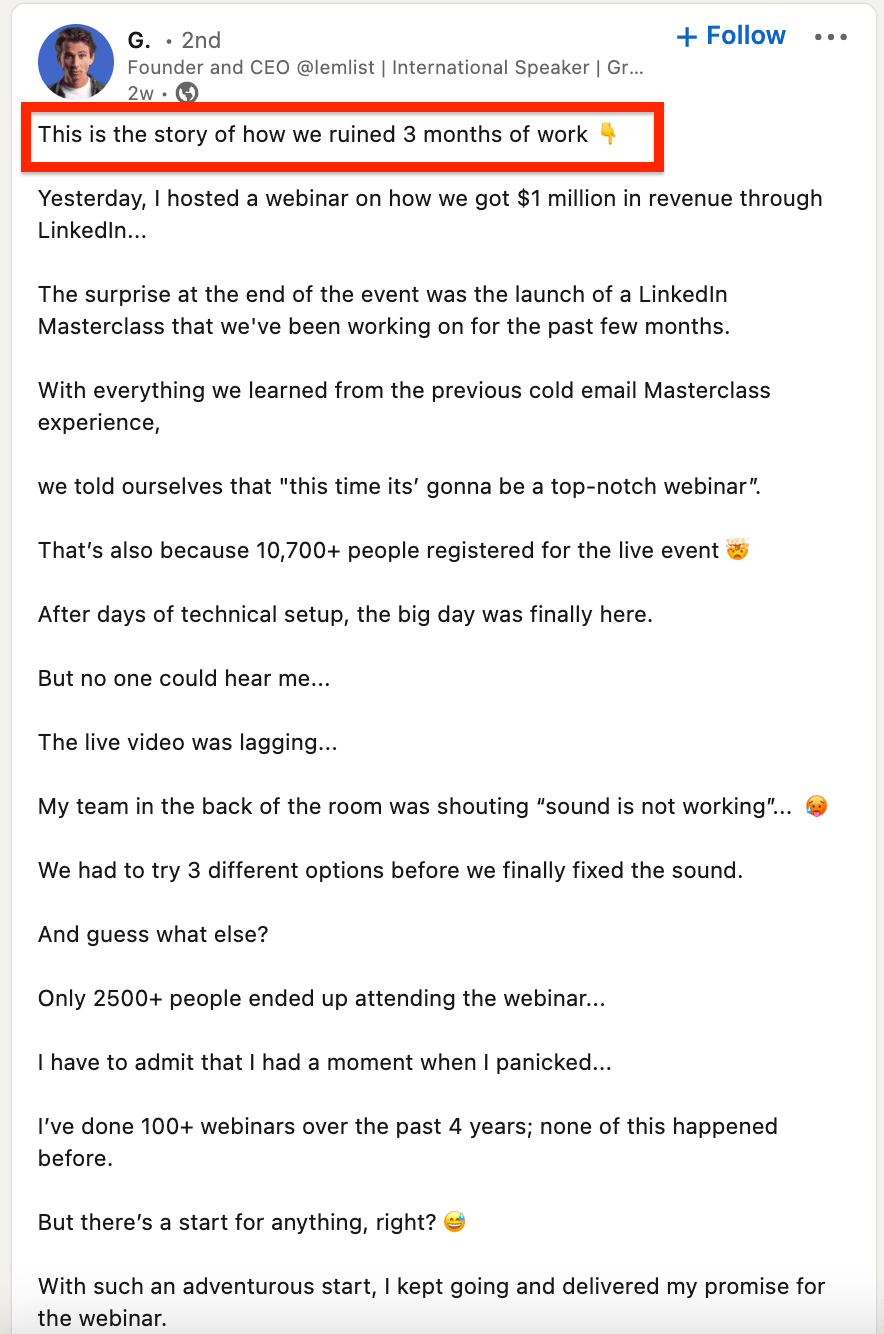
Image Source: LinkedIn
The Lemlist team, and particularly Guillaume, seem to highly value storytelling as a growth tactic that allows them to increase engagement.
In addition to storytelling, digital PR is yet another thing Lemlist makes sure to take advantage of.
Having a look at the company’s activities, we see that it’s involved in webinars, podcasts, and that Guillaume participates in different events as an international speaker.
Bottom line: This, along with other things it does like discovery calls, cold emails, improving its product based on feedback, and mastering copywriting – parts of its so-called growth circle of love – creates an efficient extrovert growth strategy all small businesses could learn a lot from.
Key Lemlist growth tactics:
- Build a community
- Focus on digital PR and raising awareness
- Strong storytelling to create engagement
Moving on.
Example #4: Kettle & Fire
Our fourth example comes from a truly fast-growing business, Kettle & Fire.
CEO and co-founder of the company, Justin Mares, says that the company is all about creating “a product that is making a positive impact on peoples’ lives and the environment”.
The way we see it, the core of its growth strategy lies exactly in this statement above, and it’s to do with customer-centric product development and creating your own niche.
Creating your own niche is about differentiating yourself from the competition.
What does that mean?
Let’s break it down.
Kettle & Fire is a company that creates high-quality bone broths, all coming from 100% grass-fed beef.
High-quality products and transparency in terms of what the animals eat are the main points that differentiate this company from its competitors and give customers a reason for trusting them.
More than feeding its animals exclusively with grass – compared to other low quality feeds – Kettle & Fire has taken bone broths to a whole new level by partnering with the Regenerative Agriculture community:

Image Source: Kettle & Fire
When most bone broth manufacturers prioritize quantity over quality, these folks are focusing on regenerative farms that help restore biodiversity in nature by adopting natural processes of preserving and cultivating the land.
Moreover, Kettle & Fire uses social media to advertise its products, run sales, and promote giveaways.
Here’s an example:
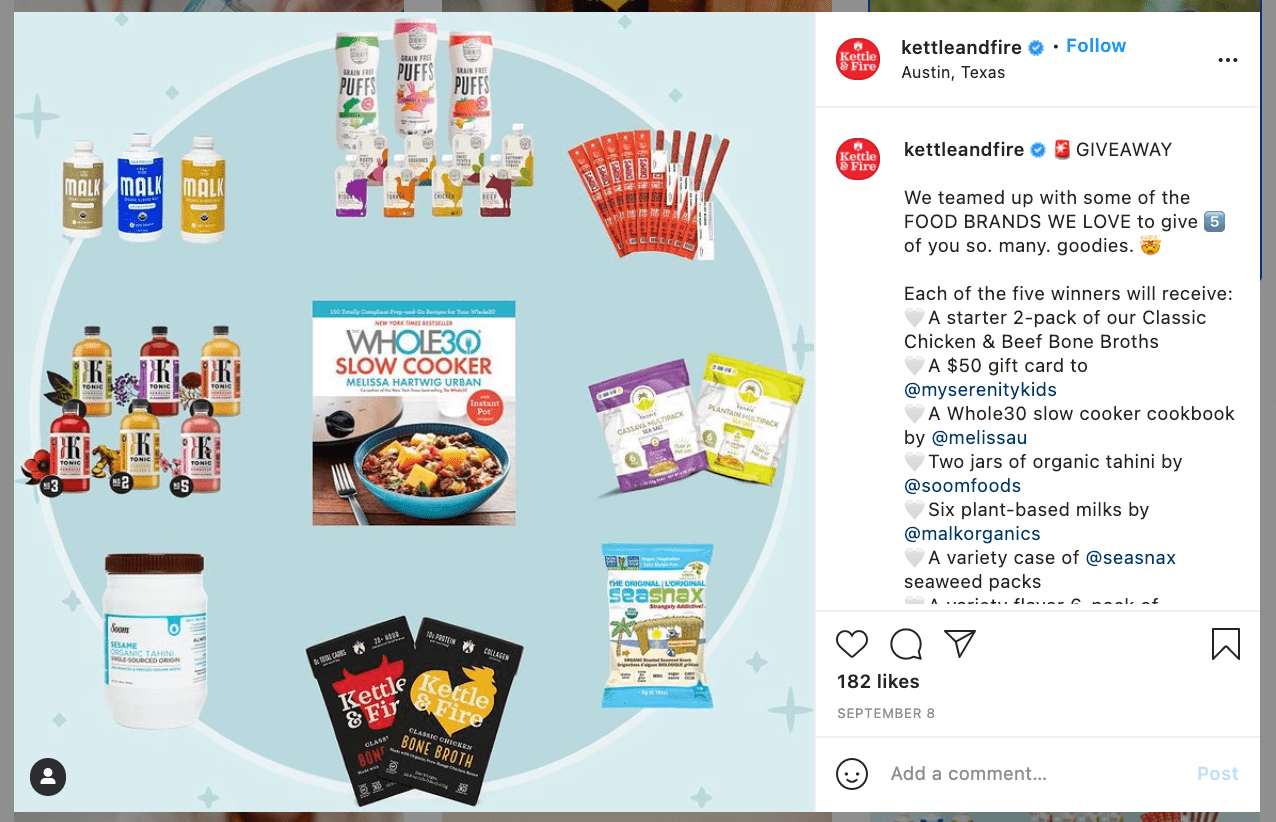
Image Source: Instagram
Needless to say that this super successful business also has a rewards program which includes a rewarding referral program, giving existing customers and their referred friends discount coupons they can redeem on purchases with the company.
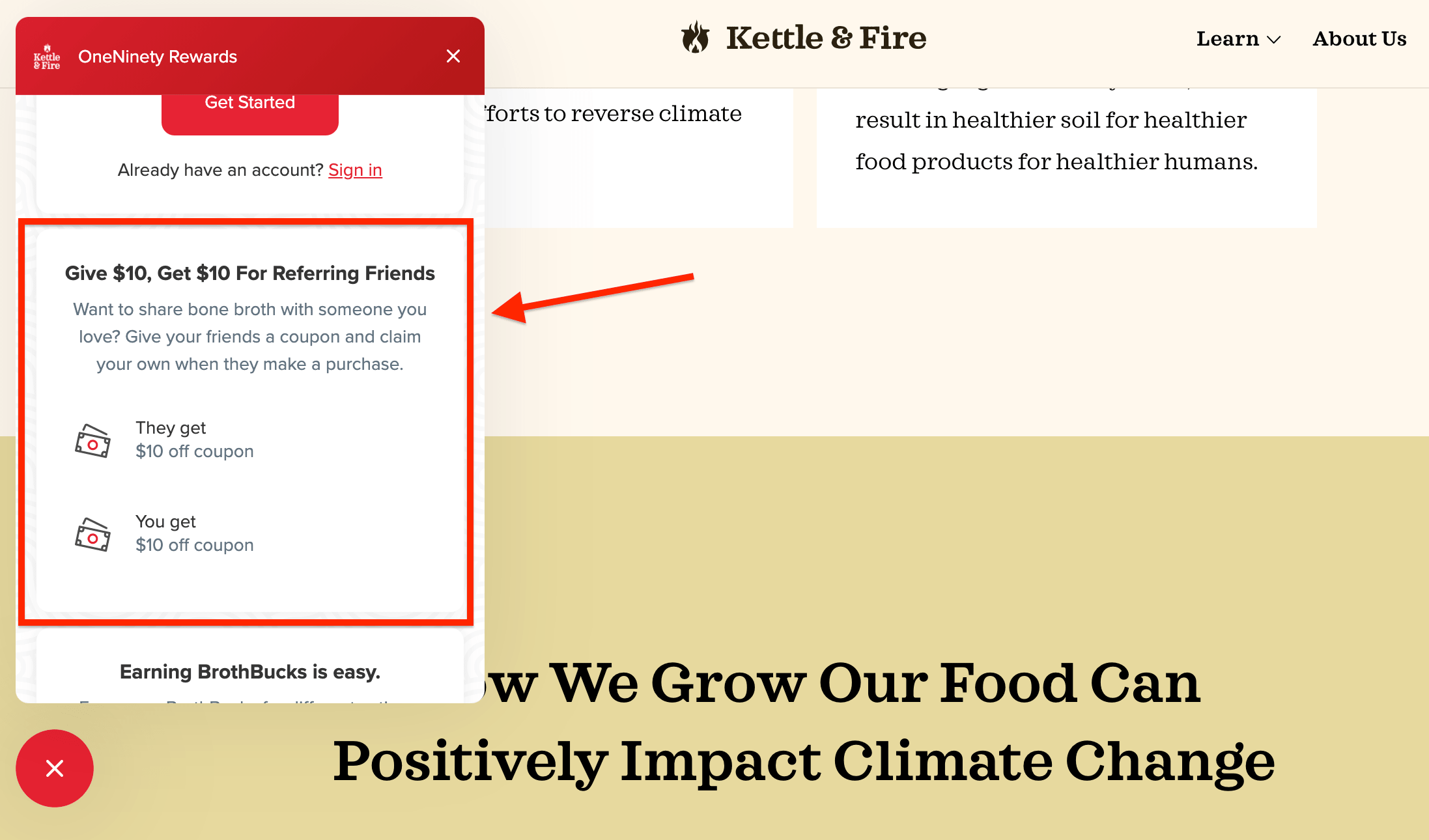
Image Source: Kettle & Fire
Once more, the way referral programs help a business grow is simple.
You grow your business by leveraging your existing customer base!
More on that a little further down in this post.
Key Kettle & Fire growth tactics:
- Stand out from competitors with a unique product strategy
- Establish a rewarding referral program
- Social media marketing
How about reading our second to last example that’s right below this line?
Example #5: Uniqlo
Our second to last example comes from the Japanese fashion brand Uniqlo.
Uniqlo, with a market value of over $105 billion, is a business with strong branding that always tries, through its messaging, to highlight how different it is from its competitors.
In fact, its take on fast fashion is almost completely different from the competition, mostly because it seems to ignore fashion completely and shifts its focus on technological innovations in relation to dress-making.
The following quote from the company’s CEO, Tadashi Yanai says it all:

Image Source: YouTube
Uniqlo is all about creating simple, affordable clothes that will make the wearers’ lives better by harnessing the power of technology and innovation.
The company has produced a range of forward-thinking products, such as the so-called HEATTECH fabrics that allow the skin to breathe in high temperatures and keep the body warm when it’s cold outside.
In terms of marketing, it makes sure to create campaigns that highlight its innovations.
An example of this is the Uniqlo UK HEATTECH promotion on YouTube…
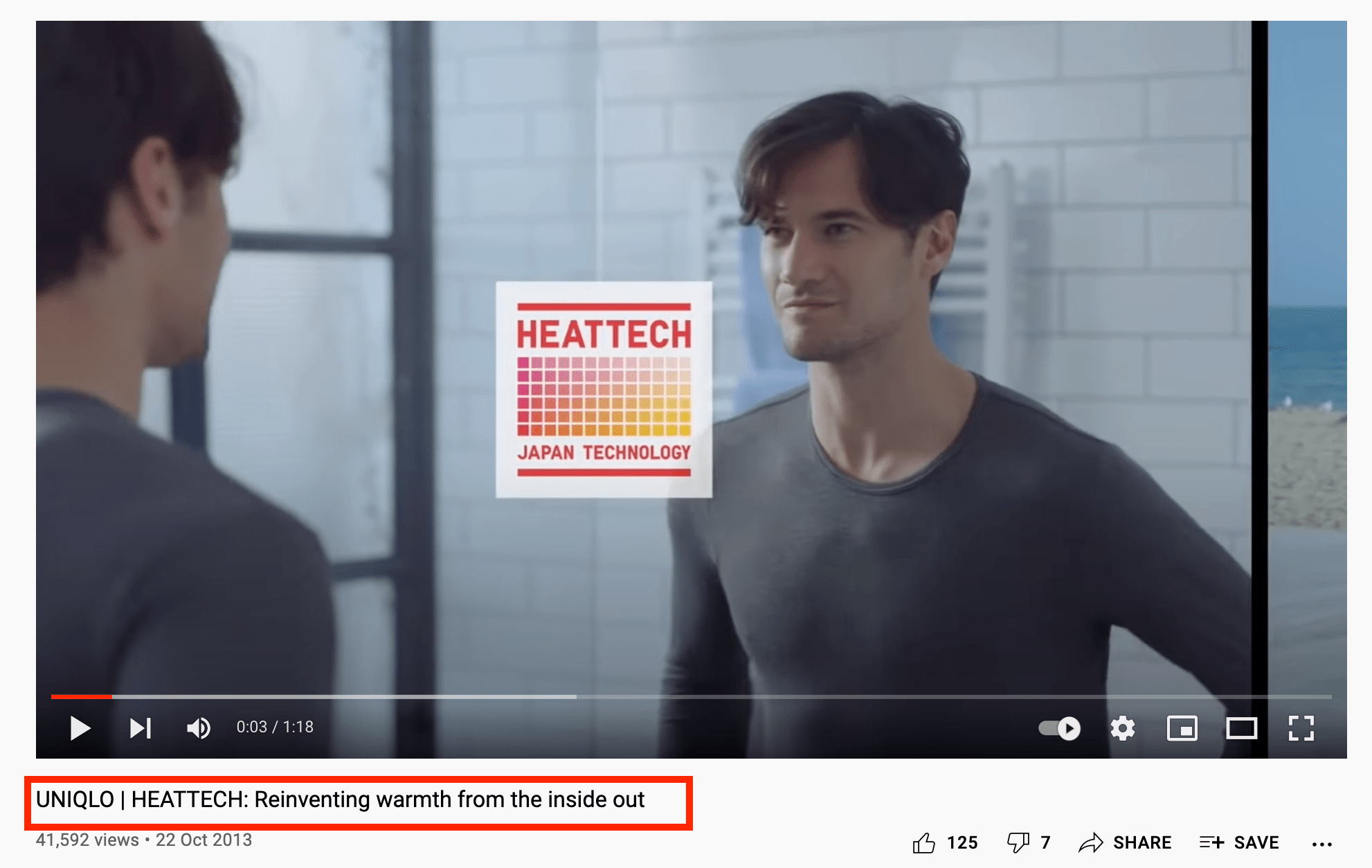
Image Source: YouTube
…or this recent Instagram post that highlights another one of its developments, its new needle for knitting fabric and making it softer.

Image Source: Instagram
In addition to its social media marketing activities, Uniqlo seems to care about building long-term relationships with its customers.
The way it engages with its customers by prompting them to create content for the brand proves it.
The following screenshot from a Uniqlo Australia promotion is quite descriptive:

Image Source: YouTube
As you can see, the company incentivizes user-generated content, thus building a community around the brand while spreading the word about its products.
Key Uniqlo growth tactics:
- Build a community
- Incentivize UGC
- Social media marketing
- Differentiate from competitors with a unique product approach
Below is our last example.
Example #6: Yumi Nutrition
Our final example is the UK-based company Yumi Nutrition.
In one sentence, Yumi Nutrition achieved impressive growth in turnover of 173% between 2019 and 2020.
In fact, the company is considered to be one of the fastest-growing companies in the UK.
Have a look:
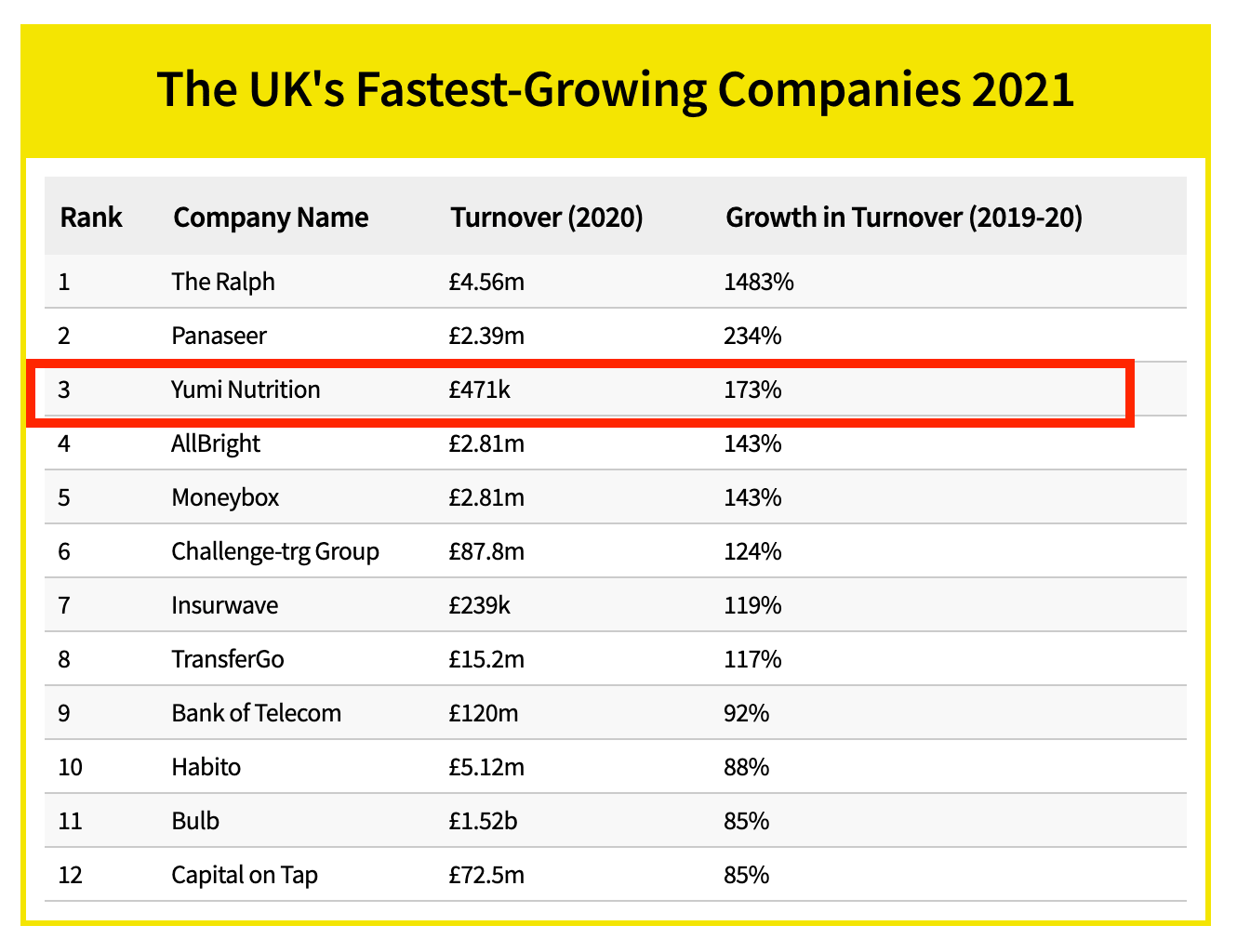
Image Source: Beauhurst
The company’s secret?
It’s making use of user-generated content, social media marketing, and influencer marketing as creative ways of getting closer to its target audience.
More specifically, Yumi Nutrition generally uses influencer marketing and giveaways as a way to reach its audience and, consequently, raise awareness of its products.
Here’s an example of one of its giveaways:
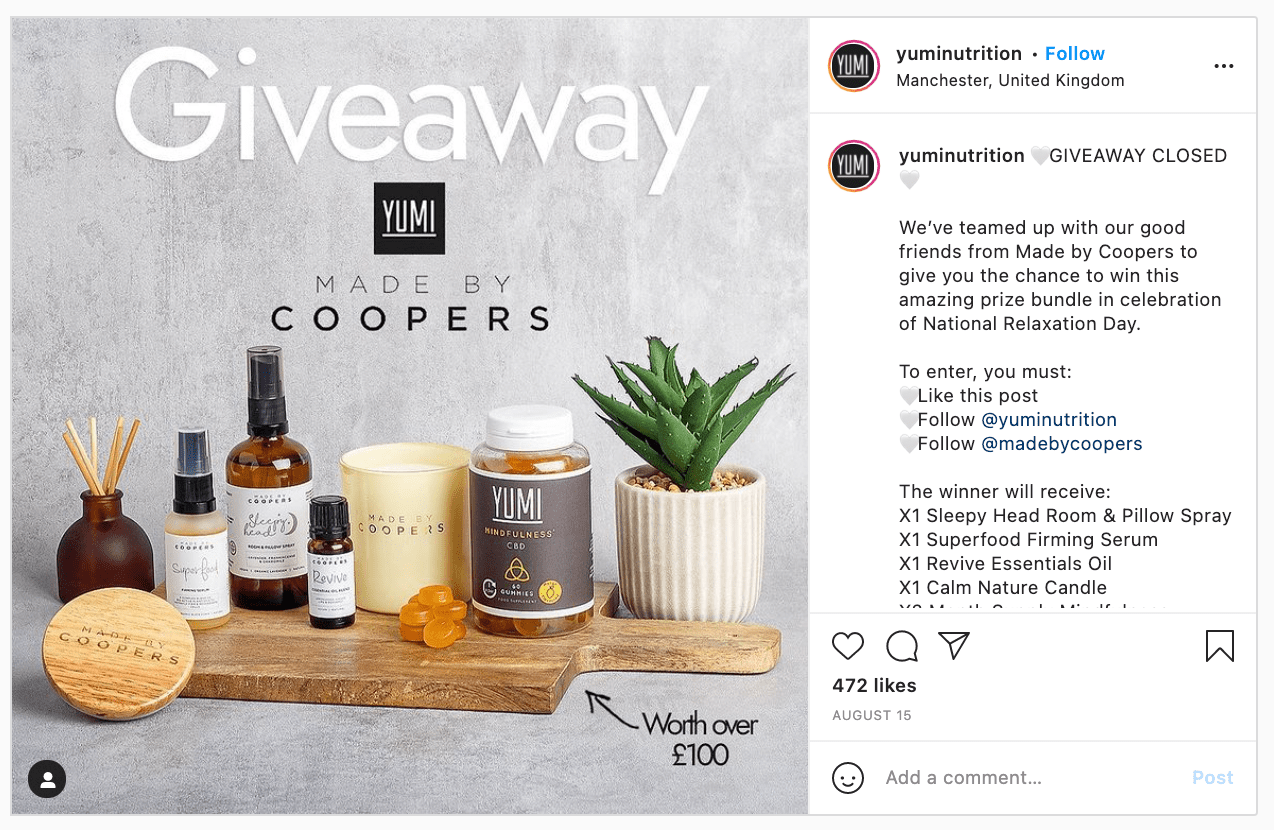
Image Source: Instagram
And here’s an example of an Instagram partnership it made with a micro-influencer:
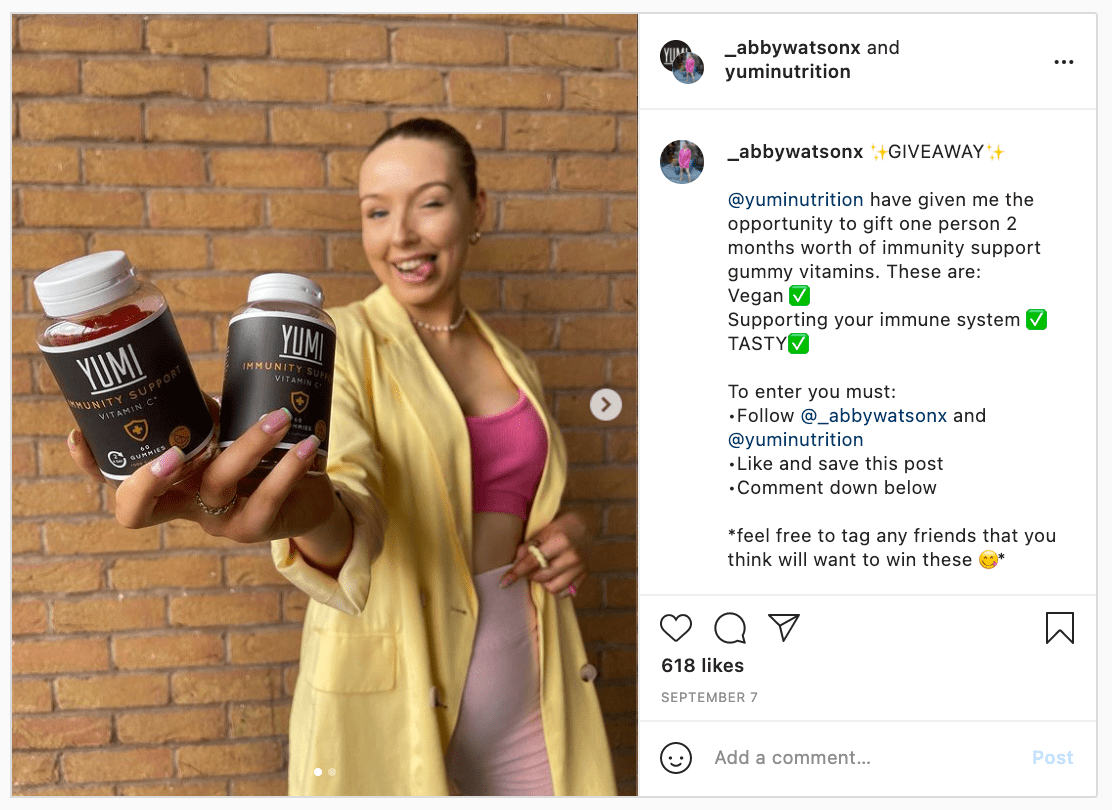
Image Source: Instagram
These growth brand marketing moves lead, among other things, to enhancing its eCommerce presence and reduce acquisition costs, thus scaling the business.
Simple!
Key Yumi Nutrition growth tactics:
- Incentivize UGC
- Social media marketing
- Influencer marketing
- Giveaways
You’ve seen the examples and now have a better understanding of what companies do to achieve exponential growth.
In the section that follows, we’re going to give you the four most prominent ways to nail growth marketing.
The 4 Most Prominent Growth Marketing Tactics to Implement
We’ve already seen six examples of companies from various industries that have managed to achieve impressive growth.
As you may have noticed already, these companies have done different things in order to grow.
In general, there are several growth tactics, over and above traditional marketing, a company could make use of.
For example, some companies might focus on implementing a new A/B test or push notifications to see which features users like better.
Similarly, some others might focus on ongoing product development.
Last but not least, many of them might invest in storytelling or creating efficient referral programs that’ll bring them closer to their audience and will allow them to create long-term relationships with them.
What’s common in all growth success stories is that they don’t talk first about pricing and business; instead, they take the long road of creating something that’ll last.
Having said that, let’s dive a bit deeper into our first tactic and how it can help your company grow.
Tactic #1: Establish a referral program
First things first, referral programs can be implemented in all types of businesses, which means that there are referral programs for eCommerce, like Glossier we discussed a little further up, as well as SaaS referral programs.
Let’s have a look at the Glossier referral program:
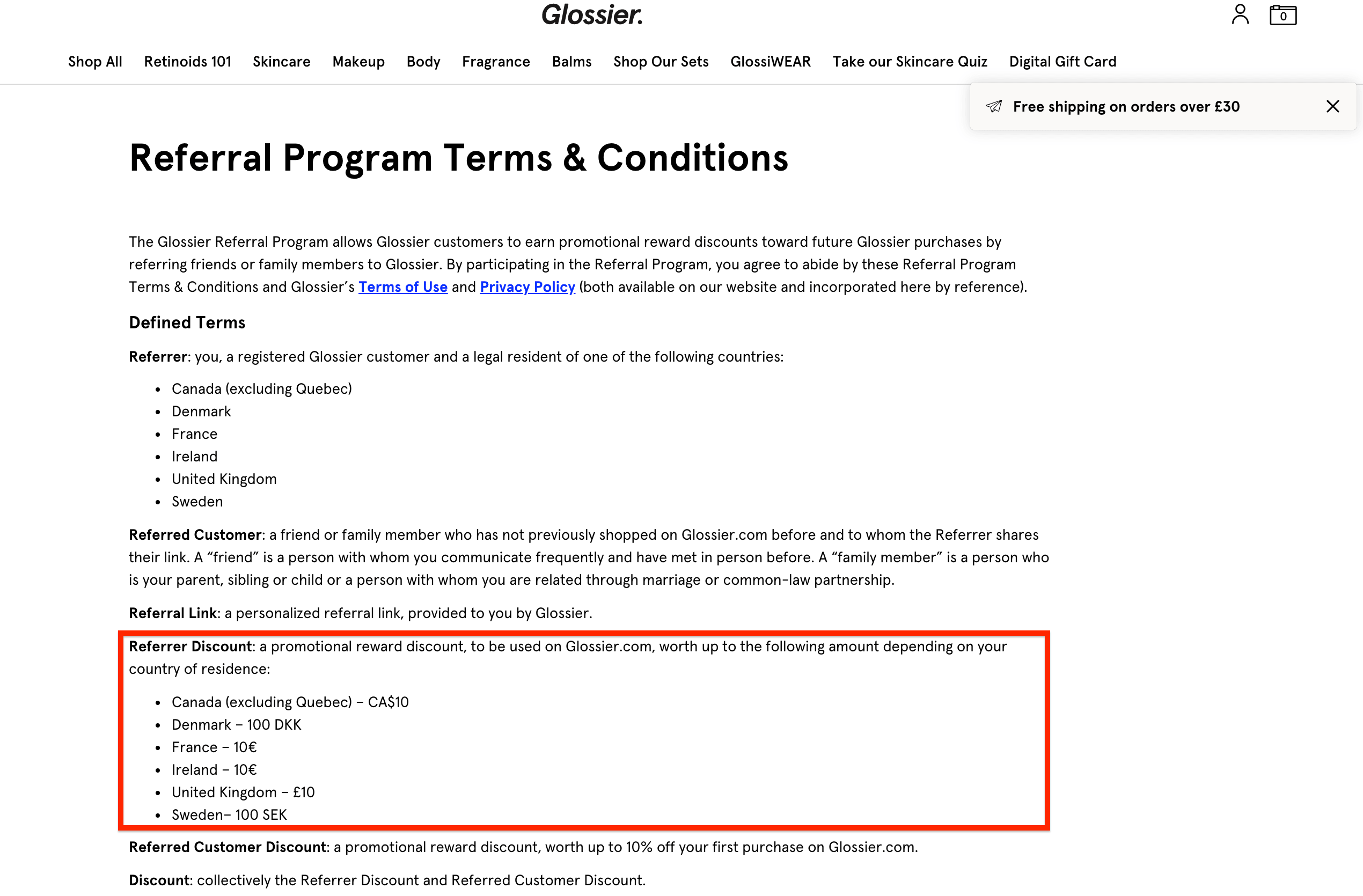
Image Source: Glossier
Like most referral programs, this one by Glossier is pretty straightforward.
The referrer, a registered Glossier customer, refers a family member or friend who’s not already registered with the brand by sharing their referral code or referral link.
The referred customer then gets 10% off their first purchase with Glossier, while the referrer receives a promotional reward discount.
This tactic empowers happy customers to spread the word about the company and earn referral reward discounts, like the ones shown above, from the Glossier designated referral landing page.
Generally speaking, all referral programs are based on the very simple fact that, when you’re happy with the product you bought or a service you’ve used, you’re inclined to spread the word about it.
That’s where referrals come in.
Referrals are a way of leveraging customer satisfaction by giving satisfied customers incentives to share their positive experiences and invite their loved ones to join their favorite brands for a great customer experience.
We’ve all heard about how well-known companies like Dropbox and Airbnb have used referrals to grow their business.
By the way, Dropbox still does!
It’s no coincidence that companies that have managed to become widely known and have steadily become top players in their niches started with a solid referral program.
These companies have used referrals to turn the family and friends of their existing customers into paying customers.
Here at Viral Loops, in a very shameless plug, we want to recommend our efficient tools for your Referral Marketing efforts. And also announce that we’ve just added our best feature yet!
With Viral Loops Rewards, your account is now fully equipped to connect and send actual rewards. Through integrations with Stripe and Tremendous, sending out gifts is now a seamless process. This makes the process for creating your next referral campaign a breeze!
For more useful info, make sure to check out our Youtube video on Referral Rewards!👇
That’s a pretty cool thing for a growth team to do without having to look for some special growth hack, isn’t it?
Tactic #2: Organize giveaways
The second growth tactic we want to talk about is organizing giveaways.
Some might think that giveaways are a less serious thing to do or that it’s not a valid growth tactic but, actually, giveaways are a great way to attract potential customers and achieve user growth.
According to Tailwind, contest posts can help a business get increased engagement with contest content generally getting 64 times more comments than regular content.
Yumi Nutrition, which we talked about earlier in this post, is a good example of a fast-growing company that organizes giveaways on a regular basis.
In fact, it even refers to it in its profile description:
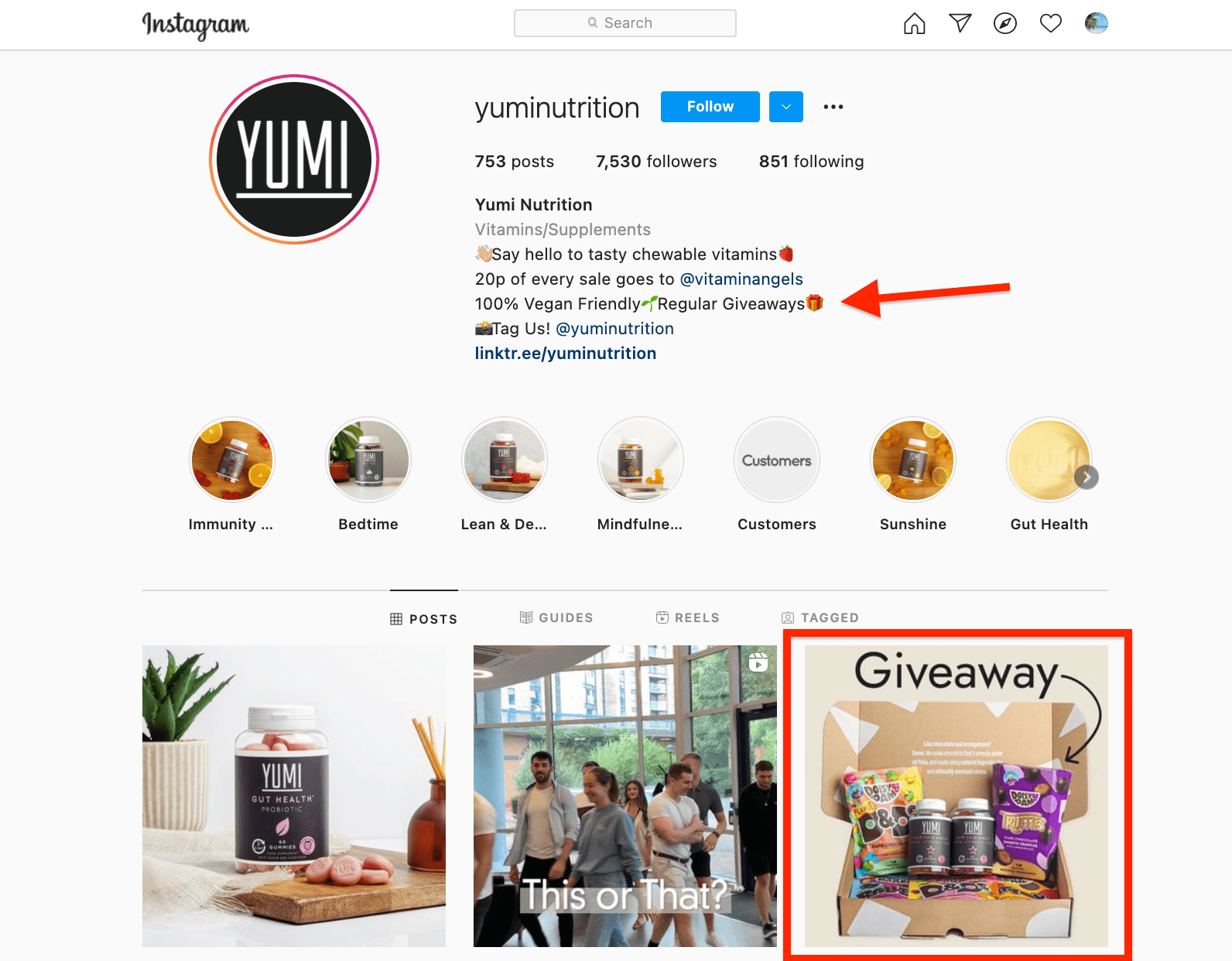
Image Source: Instagram
In terms of giveaway ideas that many companies are making use of already, there are plenty you can opt for.
Here are some examples:
- Referral marketing campaigns that give participants rewards like coupons, discounts, or early access to products and content
- Social media giveaways and contests
- Gift cards
- Instagram giveaways facilitated by influencers
- Hashtag contests
- Photo contests
And so on and so forth.
To sum up, giveaways can help you connect with your target audience, make more and more people aware of your brand, and most importantly, give back to your audience that supports you by buying your products and using your services.
Think of it this way: A giveaway is like offering your audience a gift, thus increasing your chances of these people appreciating your brand more and making them want to engage with you in the future.
Let’s get to the next tactic.
Tactic #3: Tell stories
What most of the examples that we examined earlier in this post showed us, is that in order to keep your audience engaged, you need to tell stories.
This means that it’s essential to use storytelling to convey your message and communicate with your audience in an efficient and direct way.
The reason why storytelling is important is quite simple.
Through stories that you create and narrate to your audience, you make people know more about your brand and subsequently, make them more familiar with your brand story and everything your brand stands for.
Think about one of the examples that we talked about earlier, Uniqlo.
What Uniqlo and many other brands are doing is to create stories which it shares with its audience in order to let them know more about all the important things the company stands for.
In the case of Uniqlo, the company focuses on telling stories that’ll highlight its timeless, comfortable pieces that can be worn for years.
A look at its Instagram posts highlights how much the company cares about showing its audience that its clothes are comfortable wardrobe staples that go beyond ever-changing fashion trends.

Image Source: Instagram
People who engage with these stories are more likely to see themselves wearing Uniqlo garments instead of imagining themselves wearing garments from competitors that don’t have an equally strong story.
Similarly, if we look closer into this success story of Lemlist, we see that early in the creation of the business, Guillaume, the CEO and co-founder, hired a video editor to help him create a documentary-like series featuring the startup journey.
We can only assume that part of the success and growth of the Lemlist community comes from the fact that users can access relevant content that sheds light on the company’s journey and make them feel familiar with the Lemlist team.
Have a look at the Lemroad series:
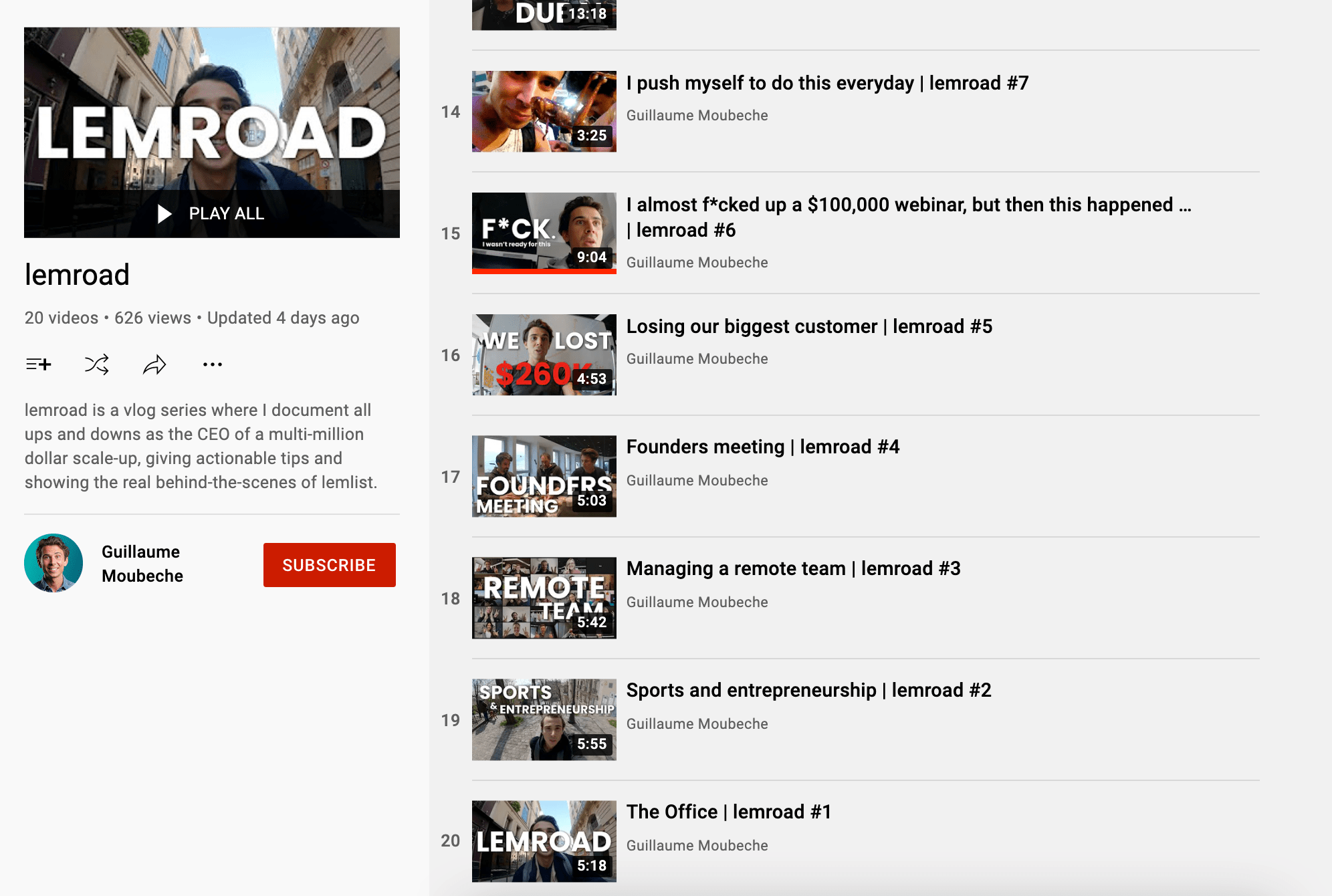
Image Source: YouTube
Making people feel familiar with you comes with loads of benefits, most of which fall under the category of relationship marketing which we’re discussing right below.
Tactic #4: Invest in relationship building
Investing in relationships in business is all about improving engagement throughout the whole of your marketing funnel.
To put it simply, relationship marketing is about creating an efficient and seamless customer experience that’ll make customers stick around.
Among other things, this can help reduce the customer acquisition cost because repeat customers tend to be much more valuable than single customers.
Have a look at the bar chart that follows:
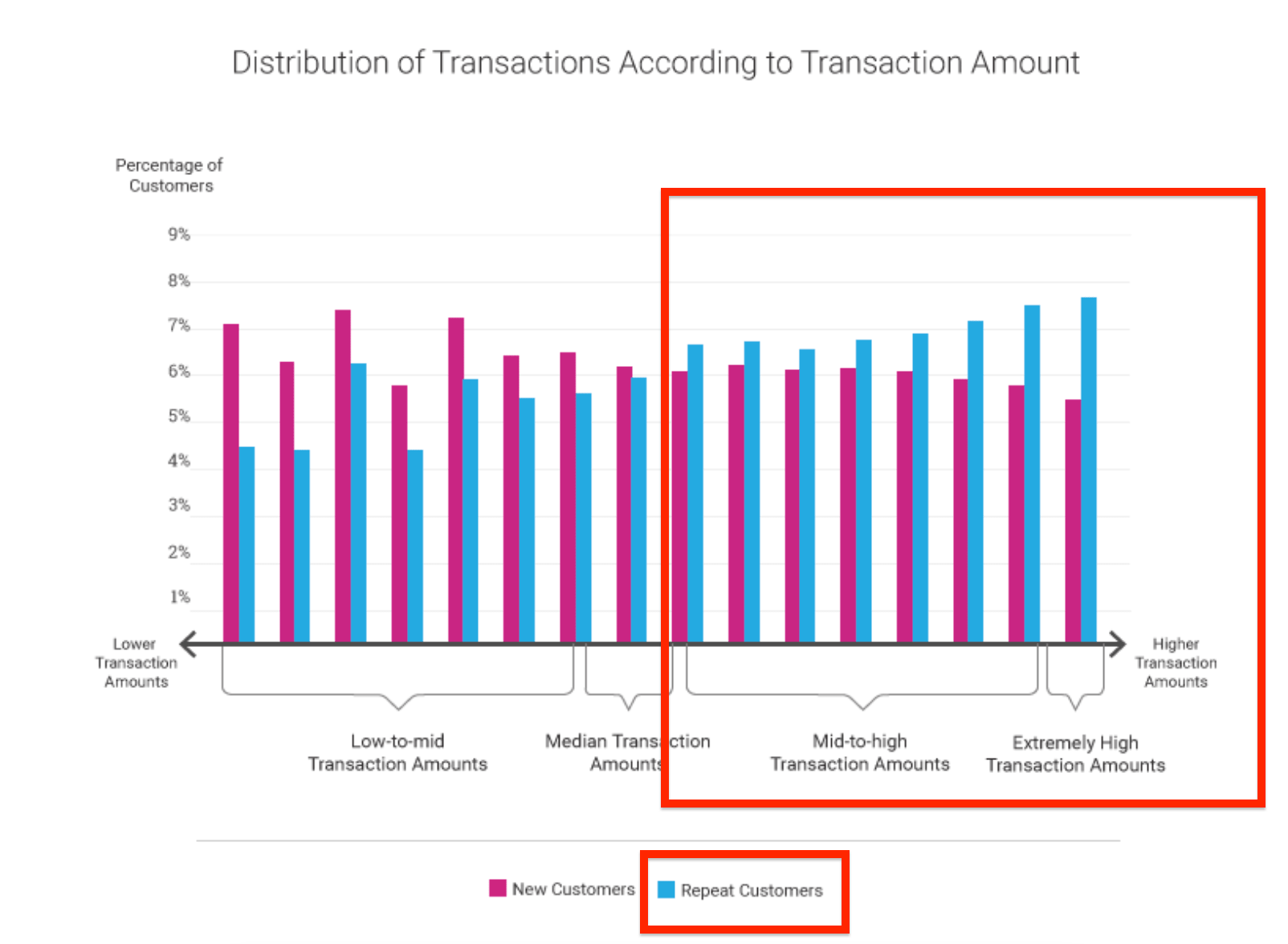
Image Source: Optimove
The distribution of transactions between new customers and repeat customers during holidays clearly shows that repeat customers generally spend a higher amount per transaction than new customers.
Following that, there are several reasons why relationship marketing is important and can be quite beneficial for a business.
These are some of the reasons:
- Increased customer loyalty
- Reduced advertising costs
- Optimized customer experience and customer journey which leads to repeat business
Overall, we could say that relationship building is key when it comes to growth marketing.
That’s because growth marketing doesn’t merely focus on the top of the funnel, which is to get more people to know about you, but it takes valuable action in terms of making customers stick with your business.
Let’s wrap up.
Before You Go
You made it all the way to the end of our growth marketing guide.
We’ve talked about the importance of growth marketing in terms of not only acquiring new customers, but also of creating long-term relationships with your existing ones.
Before we go, we need to highlight the role of word-of-mouth marketing and referral programs in the process of creating those long-term and valuable relationships.
There are, obviously, many different tactics.
However, a referral program can help any business not only raise awareness of its products and services, thus expanding its customer base, but also make sure to maintain its current customer base and keep its customers happy and engaged.
Feel free to download our free ebook…
…and get even more insight into referrals and how they work.
Thank you for reading 🙂
